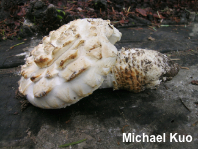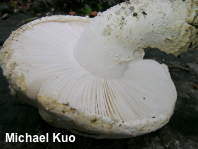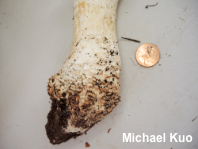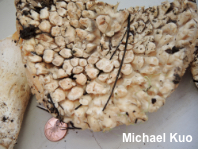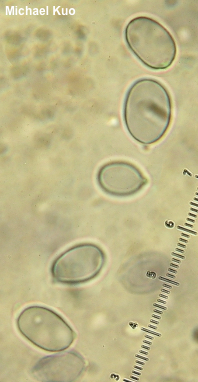| Major Groups > Gilled Mushrooms > Pale-Spored > Amanita > Amanita magniverrucata |

|
Amanita magniverrucata [ Basidiomycota > Agaricales > Amanitaceae > Amanita . . . ] by Michael Kuo White Amanita species in section Lepidella are notoriously difficult to separate, but Amanita magniverrucata is fairly easily recognized by its huge pyramid-shaped warts, its slightly rooting stem base, and its range (from northern California to Baja California). Amanita cokeri is similar, but its warts are much smaller, and its stem base features prominent, peeled-back scales—and it appears thousands of miles away, in eastern North America. Thanks to University of California Herbarium for facilitating my study of the collection cited below. Description: Ecology: Mycorrhizal; originally recorded under Bishop pine, but since reported under other conifers and, according to Jenkins (1986) and Tulloss (2013), under coast live oak; winter; originally described from California; distributed from northern California to Baja California. The illustrated and described collections are from California. Cap: 5–15 cm; convex, expanding to planoconvex; when young with an inrolled margin; covered over the center with very large, pyramid-shaped warts, and towards the margin with smaller warts; whitish, sometimes bruising and discoloring slightly brownish; the margin often appendiculate with hanging veil material. Gills Free from the stem; close; whitish, becoming a little brownish with old age; with frequent short-gills. Stem: 5–18 cm long; 2–4 cm thick; equal or tapering slightly to apex; whitish; sometimes bruising and discoloring brownish to reddish brown; bald or finely hairy; with a large, white, delicate ring that is often lost by maturity; with a swollen base that usually has a root-like extension; with whitish veil material at the base, usually appearing as concentric zones of soft scales at the top of the bulb and the lower part of the stem. Flesh: White; unchanging when sliced. Odor: Unpleasant and strong, reminiscent of spoiled meat. Spore Print: White. Microscopic Features: Spores 10–12 x 6–8 µm; ellipsoid, with a tiny apiculus; smooth; hyaline in KOH; amyloid. Basidia 32–35 x 10–12 µm; clavate; 4-sterigmate. Hymenial cystidia not found. Pileipellis not differentiated. REFERENCES: H. D. Thiers & J. Ammirati, 1982. (Thiers, 1982; Arora, 1986; Jenkins, 1986; Phillips, 1991/2005; Tulloss, 2009; Tulloss, 2013; Desjardin, Wood & Stevens, 2015; Siegel & Schwarz, 2016.) Herb. UC 1860059 (TD Bruns 3503). Herb. Kuo 01121807. This site contains no information about the edibility or toxicity of mushrooms. |
© MushroomExpert.Com |
|
Cite this page as: Kuo, M. (2022, May). Amanita magniverrucata. Retrieved from the MushroomExpert.Com Web site: http://www.mushroomexpert.com/amanita_magniverrucata.html |


